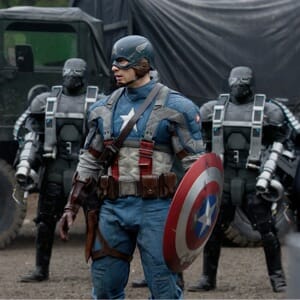
Captain America: The First Avenger is the kind of awkward failure that was hinted at already this year with Marvel Comics’ Thor and nearly spelled disaster with DC Comics’ Green Lantern. While not a terrible film, Captain America lacks the edge necessary to truly capture viewers’ imagination.
The classic comic book hero Captain America (or “Cap” as he’s often called), started back in 1941, even before Pearl Harbor. Billed as a patriotic superhero, the character was a reaction to the events in Europe during World War II. After a popular run in which the book sold as many as one-million copies per month and was revived the first time during the immediate post-WWII era, Captain America was eventually brought back by Stan Lee in the 1960s in an issue of the Marvel comic The Avengers.
Cap’s origin story in the comics is far more interesting than the one presented in this big- budget extravaganza. Steve Rogers (Chris Evans), a sensitive art student and a puny physical specimen, desperately wants to join the military in hopes of fighting Hitler. Conceived in the months prior to Pearl Harbor, Rogers becomes Captain America and later goes on to combat the Nazis, primarily in the form of the evil twisted scientist Johann Schmidt, later dubbed The Red Skull.
The movie’s take on Rogers’ story fails to spend enough time telling us who he is. Played by the beefy Chris Evans, the filmmakers do make a smart decision to have Evans play Rogers both before and after his amazing transformation into Captain America. Through the use of seamless computer animation, Evans is shortened and slimmed down from hunk to 90-pound weakling. The effect is striking.
The first third of the film shows great promise, although I’d have liked to have learned more about who Rogers is, what happened to his parents (the brief explanation isn’t enough), and a little more about his artistic side. When the story moves from character development to action, though, it loses focus and credibility. Little effort is made to tighten the villain, The Red Skull (a menacing Hugo Weaving), and make him anything more than just a one-note baddie. Missing is any appreciation of Skull’s motivations and inner torment. He’s just a vicious megalomaniac with unique facial deformities. Telling his origin story with a little more definition may have made us care and even fear the guy. Compared to Sebastian Shaw in this summer’s X-Men: First Class (Kevin Bacon perfect for the role, and the script kept us guessing as to what he would do next), the Red Skull just seems dim-witted.
Captain America: The First Avenger is a bigger film than it should have been. While the period setting is the epic WWII environment, the fictitious events depicted involve one rogue Nazi hell-bent on world domination. The movie clearly wants to set-up the bigger _Avengers _film that is coming next year. And to that end, the technology employed by The Red Skull is subtly credited to the realm belonging to Thor. But since that link is kept so cloaked, some viewers will find Skull’s various machinations and hoards of faceless, futuristic, ray gun wielding henchman unbelievable. Early in the movie, the Skull acquires a mystic power source and later uses it to run his industries and weaponry. But the time compression of the script makes the development of Skull’s operations way too fast. He has not one but many enormous plants armed with guns and tanks that would rival anything created today. It’s all a little too much. By the time the action-packed conclusion comes round, the story has gone so far off the rails that viewers might have a hard time engaging.
And sadly, the action sequences aren’t really of note, especially given all the other movies that have done this sort of thing before. It’s almost as if the script runs out of ideas and fills in the gaps with one battle after the next, trading intelligence and strategy for full-frontal attacks. This is where sophisticated audiences will check out, and even groan a bit. The Red Skull’s weapons are so powerful that anything else looks like a child’s toy. And yet, over and over again, he’s thwarted by what appears to be a small group of machine-gun-toting GIs. Had Skull had a little more control of his own equipment, the whole film would have had a harder, more credible edge. Instead, director Joe Johnston, who made the better and more focused “The Rocketeer,” seems intent on impressing us with larger and larger sets, and on populating the screen with armies foreign to any known battlefield let alone the product of the WWII period.
Captain America: The First Avenger is presented in the ubiquitous 3D format, and that aspect of the film is worth talking about. Cap is armed with an indestructible shield and when he throws it at his opponents, it flies out into the audience. While this effect is solid and the images in the film are much brighter than other 3D offerings of late, it fails to save this weak Marvel comic book entry.